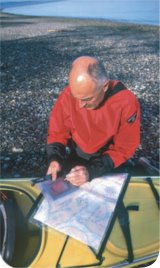SeaKayaker Magazine Review
by Tim Walsh, December 2001Fixed Foot Pegs With Rudder Control:
The SmartTrack Rudder System
This article contains excerpts from a four page review. For the full review, please visit a newstand nearest you, or the SeaKayaker Magazine website.This article has been reprinted with permission by the author and Magazine
“ Critics of kayak rudders have long argued that rudder systems that require sliding foot braces to control the rudder sacrifice not only much of the energy used to propel the kayak forward, but overall kayak control. They have also lamented that rudders, due in part to their primitive design, create excess drag, making for a wearier paddler at day's end.”
“The SmartTrack Control System, with solid foot braces, toe-operated rudder control, and a foil-section rudder blade, was designsed to address these complaints. ”
“ I was impressed to find a set of clear, concise intructions including clear graphics and a contact phone number for further information packed with each subassembly. ”
“ All parts and pieces are made of stainless steel, plastic or other material resistant to the corrosive effects of salt water. ”
“ The cables attach to the tiller bracket with a device called the Cool Rudder Wedgie (CRW). The CRW makes the process of securing the rudder cables quite painless compared to other methods I have seen employed. In fact the CRW is itself a revolution in the installation of rudders. ”
“ When I completed the installation I was pleased that, unlike during my barbeque project, there were no extra pieces on the ground, I had made no trips to the hardware store and I had used only PG-rated language. ”
Performance Review
“With the foot braces adjusted to a comfortable position, I took to the water. As I paddled away from shore I reached down to release the rudder control line from the cinch cleat to deploy the rudder. There was a satisfying "thunk" as the coiled spring dropped the rudder down into the water. The sound of the rudder dropping into position left no doubt that the rudder was down. I paddled over some bull kelp at the water's surface. The rudder slipped up, then back down with a softer - yet just as reassuring - "thunk." Paddling over other obstacles, even rocks hidden slightly below the surface of the water, provided the same positive results. To retract the rudder back to its stowed position, I gave the rudder control line a light pull and with very little resistance the rudder slipped up and stowed in its vertical posistion. ”
“ I focused next on the rudder's tracking control and turning. I quickly noticed the power I gained with the solid foot braces. When paddling, much of the energy put forth by the paddle stroke is transferred into moving the kayak forward via the foot pedals. If the foot pedals slide, as in most other rudder systems, there is a loss of efficiency. The SmartTrack system's fixed foot braces offer a significant advantage in the transfer of energy to the kayak.”
“I started turns by pressing one of the Toe Pilots forward to turn the kayak. I was surprised by how little deflection of the rudder was required to turn the kayak. With other rudder systems it is often necessary to "kick" the rudder hard one direction or the other to attain full deflection; however, I did not find this necessary with the SmartTrack system. ”
Conclusion
“A fixed foot brace rudder system is a great improvement over sliding foot braces, and the SmartTrack system is a quantum leap in the right direction.”
“Overall, the system performed very well. It installed easily, and was simple to operate and adjust while underway. More important, it did a fine job of providing tracking control and turning while supplying rock solid foot braces for more secure boat handling. ”Tim Walsh is an avid sea kayaker and an ACA Coastal Kayak Instructor living in Seattle.

